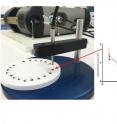A quick and easy new method to detect Wolbachia bacteria in intact Aedes mosquitoes
Aedes aegypti mosquitoes transmit dengue, chikungunya, and zika viruses. A study published in PLOS NTDs reports a new technique that could make one approach to mosquito control--using Wolbachia bacteria that reduce the mosquitos' ability to transmit viral pathogens--a whole lot easier and cheaper to implement and evaluate. Wolbachia naturally infect many insect species but not Aedes aegypti mosquitoes. However, Wolbachia can nonetheless be introduced into the Aedes population, where they subsequently spread as mothers pass them on to offspring. Even benign Wolbachia strains, which seemingly peacefully co-exist with their Aedes hosts, can block the growth of viruses, including dengue and zika, in the mosquitoes. A different approach uses more harmful Wolbachia strains that have been shown to reduce the fitness of infected mosquitoes. This reduces the mosquito population at the same time as blocking replication of the virus. Both approaches require careful monitoring of the spread of Wolbachia in the wild mosquito population. Molecular techniques can reliably detect Wolbachia DNA in carefully prepared mosquito extracts, but are complicated and costly.
Near-infrared spectroscopy (NIRS) is a fast and non-destructive method to determine the chemical properties of diverse samples that has many applications in science and medicine. It shines light of a specific wavelength at the sample and detects a characteristic spectrum in the reflected light. The technology had previously been successfully applied to discriminate age and species of mosquitoes transmitting malaria in Africa and to detect Wolbachia in fruit flies. In this study, Maggy Sikulu-Lord, from QIMR Berghofer Medical Research Institute in Brisbane, Australia, and colleagues examined the potential of using NIRS as a high throughput technique for detecting the presence or absence of Wolbachia in male and female Ae. aegypti mosquitoes.
The researchers started by applying NIRS to male or female mosquitoes that were known to be Wolbachia-free or had been infected with either a benign (called wMel) or a more aggressive (wMelPop) Wolbachia strain. Based on these read-outs, they developed prediction models for the analysis of mosquitoes with unknown infection status. Using the calibrated models, the researchers then applied NIRS to a random mix of mosquitoes and checked the results against validation tests using mosquito extracts for molecular detection of strain-specific Wolbachia DNA to determine accuracy.
Based on roughly 300 samples each, they found that females and males infected with wMelPop were differentiated from non-infected mosquitoes with an average accuracy of 96% and 87.5%, respectively. Similarly, NIRS differentiated between wMel and uninfected females with an average accuracy of 92%, whereas infected males were differentiated from uninfected ones with an accuracy of 88.5%. NIRS was also able to distinguish between the two different Wolbachia strains with an accuracy of 96.6% in female and 84.5% in male mosquitoes. The consistently higher accuracy in females, the researchers speculate, may be due to higher Wolbachia numbers in infected females (among other tissues, bacteria are found in the ovaries) relative to males.
The researchers tested mosquitoes of different ages, but all of them were reared in the laboratory under similar conditions. Mosquitoes sampled in the wild are likely more diverse, and this might affect the NIRS read-outs. The researchers therefore acknowledge that "the models developed during this study require further validation using field collections". Nonetheless, they say, their results "show that NIRS may have real potential as an alternative method to molecular techniques for monitoring Wolbachia incidence in mosquitoes", and suggest that "this rapid, simple and cost-effective surveillance tool suitable for resource-poor areas and large urban release programs would be of great utility for evaluating Wolbachia-based interventions".
Source: PLOS
Articles on the same topic
1 more sources ClickOther sources
- Sex May Spread Zika Virus More Often Than Researchers Suspectedfrom NY Times Science8 years ago
- A quick and easy new method to detect Wolbachia bacteria in intact Aedes mosquitoesfrom Science Daily8 years ago
- Benign bacteria block mosquitoes from transmitting Zika, chikungunya virusesfrom Science Daily8 years ago
- Benign bacteria block mosquitoes from transmitting Zika, chikungunyafrom Science Blog8 years ago
- Likelihood of widespread Zika outbreak in United States lowfrom Science Daily8 years ago
- Inside the 'mosquito factory' aiming to eliminate Zikafrom CBC: Technology & Science8 years ago
- Lethal Buzzers: America’s Six Most Dangerous Mosquitoesfrom NY Times Science8 years ago
- Zika Virus Research at Biosecurity Research Institute Aims to Control, Fight Mosquitoesfrom Newswise - Scinews8 years ago


